Public Pier — No Fishing License Required
On a visit to this pier in 2013, I happened to pick up a Malibu paper for some late night reading back at the motel. The most interesting reading that night was the real estate section, which listed modest condos in Malibu for only about $5 million and up. Larger estates were of course more expensive (included one listed as a bargain at $47 million). If you only wanted to rent a place for the summer, places were available—generally for $20,000-30,000 a month. Sure, I thought, here’s my check. From that day on, I have added the term ironic to what I had always called an iconic pier.
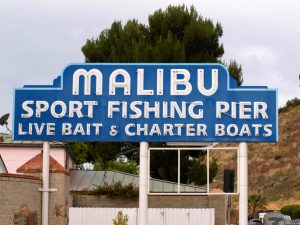
Why iconic? The pier and its twin Cape Cod-styled buildings out at the end of the pier have become world famous since construction back in the ‘40s. The pier has been seen in numerous movies and TV shows and it is certainly one of the most recognizable symbols for Malibu. Familiar and iconic too is the pier’s entrance, a virtually unchanged tower building that dates back nearly a century to the original Rindge Rancho Malibu, and the 1940’s Malibu Sport Fishing Pier sign, a sign that once set just outside Alice’s Restaurant. The restaurant would likely also be considered iconic if it was still there but it closed during the disastrous ‘90s, today it’s just a pleasant memory of a different time. Completing the iconic scene are two large, fortress-like gates that guard entry to the pier and frame a Kodak-like picture looking out to the end—the flag, the sea, the railings, the people, and the twin buildings.
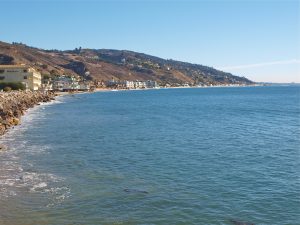
Why ironic? Malibu, or “Bu” as locals like to call it, is a 21-mile long narrow strip of coastline that is primarily home to the rich—and richer, those that can afford the prices listed above. Although a relatively short distance from Santa Monica and Los Angeles, the area exudes a totally different atmosphere than its more crowded cousins to the east. Flanked on both sides of PCH (Pacific Coast Highway) by those expensive, multi-million dollar estates, the pier itself seems just a tad bit out of place. Here, in the midst of wealth, is a free public fishing pier, one that is open to all, rich and poor, patrician and plebian (and most of the “pier rats” fall into the latter category). To me it’s definitely ironic and perhaps is the poster child for what “public” really means..
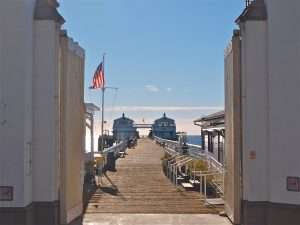
While the owners along the Malibu shoreline fight to prevent visitors from using their beaches, here sits this pier that is typically thronged by inland visitors all summer long (and on “balmy” weekend days the rest of the year). California’s “public” piers have traditionally been the fishing grounds for the poorer anglers, those who cannot afford boats or boat trips—and certainly could never afford to buy a sliver of Malibu’s shoreline. But, they can use the pier. Some of the visitors to the pier are Malibu residents but the vast majority of anglers are visitors that have come over the hill from the hotter, and far less expensive inland valleys. It’s hard to say how the Malibu folk feel about the influx of visitors but I don’t think it makes them particularly happy.
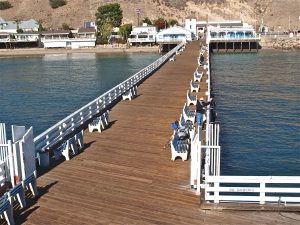
Environment and Fish. The 780-foot-long pier, small in comparison to most oceanfront piers, sits in a small bay or cove once called Keller’s Shelter. The pier’s entrance sits over a fairly narrow sandy beach and is adjacent to the Malibu Lagoon State Beach and its famous Surfriders’ Beach—home of the Gidget movies.
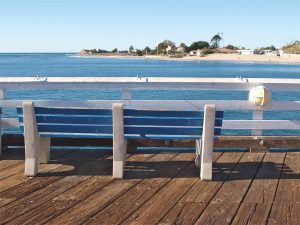
Looking toward Malibu Lagoon State Beach & Surfriders’ Beach — Note how benches and rod holders on the railings line the pier
Inshore the surf area to out past the breakers yields the typical sandy-shore species. Barred surfperch lead the hit parade followed by croakers, mainly yellowfin croaker, and a mix of small sharays—round stingrays, thornback rays, leopard sharks and shovelnose sharks (guitarfish). Although the shallow waters once seemed to produce good numbers of corbina, the number seems to have dropped in the last decade. The drop is hard to explain since pier observers still report good numbers of the “beans” in the surf area
From mid-pier out to the end, action is primarily directed toward bottom fish (for example, halibut, sharks and bat rays) or to fishing around the mussel-covered pilings for seaperch (blackperch, pileperch, white seaperch, and rubberlip). In this mid-pier area, and especially on the west side of the pier near where it widens, anglers using bait rigs like Lucky Lura’s or Sabiki’s can often catch fine strings of queenfish or walleye surfperch.
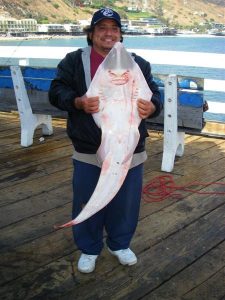
Shovelnose shark (guitarfish)
The end area itself will see all of these fish but also more pelagics: Pacific mackerel, jack mackerel, sardines, and jacksmelt. Most years will see some white seabass caught while warm water years will generally see bonito and barracuda make an appearance. The end is also typically the area for the larger sharks and bat rays and has become a favorite area the past few years for anglers seeking out thresher sharks.
It should be noted that the left and right sides of the end section are now closed to fishing. The left side is used by the Malibu Sportfishing boat(s) and space is saved for the loading and unloading of passengers. Patrons of the restaurant use the right side of the end area with several outdoor tables taking up the limited space between restaurant and railings.
Some things change, some don’t. The gates are still there but there’s no skiffs, no tickets for live bait boats or barges, and jewfish (giant sea bass) are illegal to keep.
An unusual feature of the pier at Malibu is the huge wooden medieval castle doors. Skiffs may be rented, or tickets purchased for trips on the live-bait boats or barge. At the time of our calling large catches of yellowtail, bass, barracuda and halibut were being made on the boats, while halibut and surf fishing from the pier was said to be good. We were shown three pictures of jewfish landed on the barge this season. One looked to be a whopper and was said to weigh 153 pounds. We wondered what we would do if a 300-pounder ever took our line. —Los Angeles Times, June 9, 1935
Fishing Tips. During the summer and fall months, try the surf area for corbina using live sand crabs (if you can find them). If the sand crabs are truant try bloodworms, fresh mussels, clams, or ghost shrimp. Fish just outside the breaker area using a high/low leader and small hooks, size 6 or 4. Given their shy nature and their frustrating ability to ignore the wonderful baits offered up by anglers you might also want to use fluorocarbon line and you don’t need more than 12-pound line (and some anglers use as low as 4-pound test if conditions are mild).
Winter and spring months will produce barred surfperch in this area using the same baits as for the corbina although more and more anglers seem to prefer grubbin’ for the barreds. Small root beer or motor color grubs or Berkeley Gulp (4-6 inch size) seem to catch the most fish and have the most loyal following of anglers. Summer months see more yellowfin croaker with fresh mussels, ghost shrimp and seaworms the preferred baits. For the yellowifins use a high/low leader with size 4 hooks.
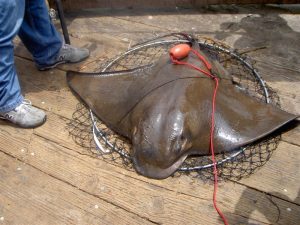
Bat ray
If seeking out sharays try a high/low leader or Carolina leader baited with a smelly baitfish (anchovy, sardine or mackerel) but use a heavier line since you never know when you might hook a good-sized leopard shark or large bat ray.
There was a time when almost every newspaper had an “outdoor” hunting and fishing writer. In SoCal most newspapers also usually had a daily fish count from each of the Sportfishing landings. Almost every year the writers would talk about the great halibut grounds along the Malibu coast, from the “Movie Colony Pier (Malibu Pier) to north of Point Dume. Boats from the Malibu Pier and Paradise Pier both specialized in halibut, often large halibut, from the area. Although less frequently mentioned, the Malibu Pier also gained a reputation for its halibut, both the number of halibut and size of the halibut. Today both the numbers and size are down but it still can be, at times, one of the better piers for halibut.
In the mid-pier area, especially April-May through September, try on the bottom for halibut using live bait (anchovies, small smelt, mini-macs, small walleye surfperch, or brown bait—queenfish, baby white croakers or lizardfish). Use a live bait Carolina rigging or a high/low-type rigging but only with one long leader a couple of feet above the sinker. Once again you shouldn’t need heavy line (12-15 pound max) unless you are also seeking out the bigger sharks and rays.
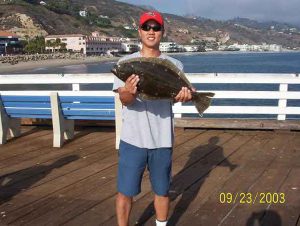
California halibut
Many other species beside halibut also like the live bait as evidenced by a duo of (apparently lost) striped bass captured by anglers in May of ’04. Both fish, a 22 and 23-incher, were caught on live shinerperch. A small run of stripers also took place at the pier in August of 2006 but whenever the Linesides show up it’s a special treat.
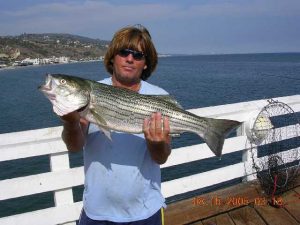
Striped bass — 2006
An increasing number of regulars seek out halibut using artificial lures. Traditionally the Big Hammers and Fish Traps have been the preferred lures but recently Lucky Craft lures have become the favorites for halibut fishermen; try using the “Flash Minnow” design in “MS Anchovy” or “Metallic Sardine” colors..
If seeking out the smaller croakers (white croaker aka tomcod) or the smaller sharays use a high/low leader, and size 4 hook. Use cut anchovies, seaworms or strips of squid for the white croaker); use squid or oily baitfish (anchovies, sardines or mackerel) for the thornback rays, round stingrays and shovelnose sharks (guitarfish). Use fresh mussels, bloodworms or ghost shrimp for yellowfin croaker. Some years will also see quite a few small, juvenile leopard sharks in the mid-pier area and be sure to let them go.
If you try around the pilings with fresh mussel you may also latch onto a blackperch, a large pileperch, or a sargo (and the numbers of sargo have seemed to increase in the last decade). The areas in between the pilings mid-pier are often good areas to try Sabikis and similar baitrigs for queenfish and walleye surfperch.
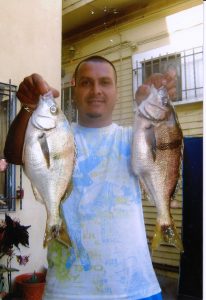
Sargo — 2009
At the end of the pier, try live bait for halibut (and flatties exceeding 40 pounds have been landed here), mackerel, bonito, kelp bass, sand bass, sculpin (scorpionfish), and a few white seabass. Remember to return to the water any under-size white seabass. A bloody piece of mackerel seems best for the sharks (gray smoothhounds, leopard sharks, shovelnose sharks) while the big old bat rays generally prefer squid.
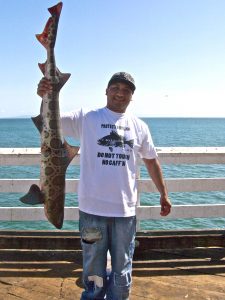
Leopard shark
A growing number of anglers target thresher sharks (primarily June to October) although most that are landed at the pier are mere babies with a body of maybe three feet and a similar-sized tail. Most should gently be released to fight another day. If released they will grow quickly and within a few years reach the size of one that was taken near the pier in 2002. Kayaker Jeff Krieger hooked a 220-pound thresher just 100 yards off the pier while trolling a Rapala lure. Forty minutes later he was able to get the big fish to the kayak, get a rope around its tail, and slit its heart with a knife. And, many, many threshers exceeding 8-feet in length have been landed from the pier itself. If you do plan to target the threshers you may want to come early. I’ve had several visits where the end of the pier was covered by anglers seeking out the threshers, and it’s first come, first served as far as space.
2002 also saw Peter Gajic, another kayaker fishing just off the end of the pier, land a 63-inch-long, 5 ½-pound ribbonfish. The fish, considered very rare to California waters, was duly measured and photographed at Wylie’s Bait Shop just down the highway (see the photo). Soon after, staff from the Natural History Museum of Los Angeles County sped out to the shop, oohed and awed, and took the fish back to the bowels of the museum where it apparently resides in perpetual peace to this day. It’s not clear as to exactly what species of ribbonfish was collected.
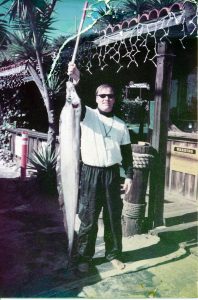 A ribbonfish at Wylie’s Bait & Tackle
A ribbonfish at Wylie’s Bait & Tackle
Lastly, a growing number of giant (black) sea bass have been showing up at the pier. Since 2007 a steady stream of reports have been given regarding the capture and release of the big fish from the pier. If you hook such a fish, or see one hooked, make sure it’s safely returned to the water unharmed.
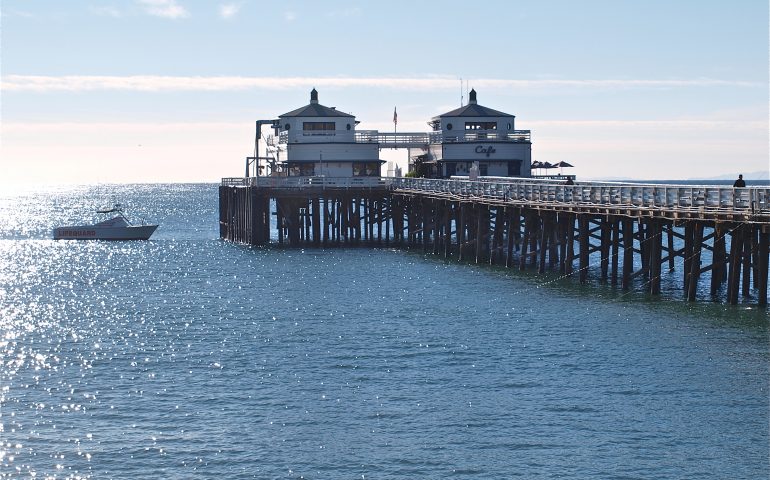
[…] on the iconic Malibu Pier, Malibu Farm Restaurant embodies the essence of coastal dining. Helene Henderson, the visionary […]